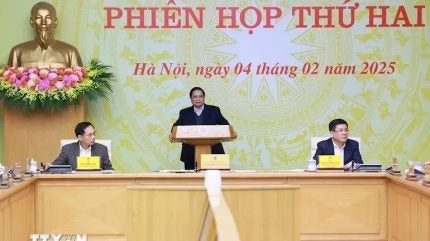
During the second session of the Steering Committee for Nuclear Power Plant Construction earlier in February, Vietnam’s Prime Minister Phạm Minh Chính requested competent authorities to accelerate the development of the Ninh Thuan project. In November 2024, the 13th Party Central Committee had agreed to restart the Ninh Thuận projects and to continue researching the nuclear power programme.
The Ninh Thuận 1 and 2 nuclear power projects had previously completed feasibility studies by design consultants, but had not been approved. As a result, a proposal has been drafted to include these projects in the Government’s nuclear power development policy scenario.
The Ninh Thuận 1 NPP project was a collaboration with Russia, which had completed and handed over the site approval documents and the English version of the feasibility study report at the end of December 2013. The Ninh Thuận 2 NPP project was a joint effort with Japan, which had completed and handed over the site approval documents and feasibility study report in 2014. The Ninh Thuan nuclear project was initially approved by the 12th National Assembly in 2009 but suspended in 2016,
At the Steering Committee, Chính requested competent authorities to accelerate the development of the Ninh Thuan project. He assigned Vietnam Electricity (EVN) as the investor for Ninh Thuận 1 and Việt Nam National Energy Corporation (PVN) as the investor for Ninh Thuận 2. He also set a target deadline to complete the Ninh Thuận nuclear power project by 31 December 2030.
Chinh requested competent authorities to accelerate development of the Ninh Thuan nuclear project. He urged ministries and sectors to ramp up efforts to complete legal institutions related to nuclear power, including the amendments to the Law on Atomic Energy. He said special policy mechanisms must be sketched out to enable the fastest and most efficient implementation of the project. They must be completed on 15 February so that the Ministry of Industry & Trade could compile and submit them to the Government for approval. In addition, adjustments to the National Power Development Plan must be finalised by 28 February.
In an effort to create the legal foundation for the two plants, the Ministry of Industry & Trade is reviewing the National Power Development Plan, to include the addition of the Ninh Thuan nuclear power plant project, as well as researching and planning the development of new NPPs. The Ministry of Science & Technology, meanwhile, is putting forward amendments and supplementation to the Law on Atomic Energy.
To ensure the 2030 target for completing the plants is met, Chinh, ordered the creation of a schedule, with clear tasks to relevant ministries, sectors and localities. Additionally, he laid stress on the need to negotiate with partners regarding technology, investment, and mechanisms to attract human resources for nuclear power development.
Regarding the selection of foreign partners to participate in the project, the prime minister said that “in accordance with the Central Committee’s conclusion, the National Assembly’s resolution, and the Politburo’s direction, EVN, Petrovietnam and other agencies must send a working delegation to negotiate with foreign partners in February, paying attention to having back-up partners to be ready in all situations”.
He ordered the south-central province of Ninh Thuan to expedite the site clearance and resettlement work to stabilise local livelihoods, production and business this year while joining hands with ministries, sectors, agencies, and enterprises to upgrade the Thanh Son Airport to serve both military and civilian purposes, supporting the nuclear power plant project and regional socio-economic development.
He requested coordination with the International Atomic Energy Agency on relevant issues, feasibility study assessments, enhanced communications work, and monthly meetings of the steering committee to monitor progress and address challenges promptly.
Meanwhile, the Ministry of Industry & Trade is also assessing the potential for developing other NPPs identifying five new localities suitable for large-scale nuclear projects in the south central, central and north central regions.
A draft revision of the National Power Development Plan for 2021-2030, with a vision to 2050, is currently open for public feedback. In it the Ministry has identified eight potential locations across the five localities.
In Ninh Thuận Province, the proposed locations are Vĩnh Trường Hamlet (Phước Dinh Commune, Thuận Nam District), Thái An Hamlet (Vĩnh Hải Commune, Ninh Hải District) and Bãi Chà Là (Bình Tiên Hamlet, Công Hải Commune, Thuận Bắc District).
In Quảng Ngãi Province, the proposed locations are Gia Hòa Hamlet (Đức Thắng Commune) and Văn Bân Hamlet (Đức Chánh Commune).
Other locations are Lộ Diêu Hamlet (Hoài Mỹ Commune, Hoài Nhơn District, Bình Định Province), Phú Hải Hamlet (Xuân Phương Commune, Sông Cầu District, Phú Yên Province), and Sơn Tịnh Hamlet (Kỳ Xuân Commune, Kỳ Anh District, Hà Tĩnh Province).
Each site has the potential to develop approximately 4-6 GWe of nuclear power capacity. The Ministry says NPPs could be considered in three key regions – the south-central region with potential capacity of 25-30 GWe, the central region with around 10 GWe and the north-central region with approximately 4-5 GWe.
To date only Phước Dinh and Vĩnh Hải have publicly announced site planning for NPPs. Other potential sites are being considered for the development of four large-scale nuclear reactors. However, with no formal planning, these sites will require reassessment to identify possible socio-economic changes in the areas.
As to the construction of small modular reactors (SMRs), the Ministry said site selection is a crucial step in integrating SMRs into the regional energy system. This significantly impacts construction costs, environmental health, safety and other operational aspects. Numerous SMR designs are currently under development at various stages worldwide. Vietnam currently has no legal regulations regarding site requirements for SMRs. In the absence of specific guidelines, the process must comply with the existing regulations for large-scale NPPs.






